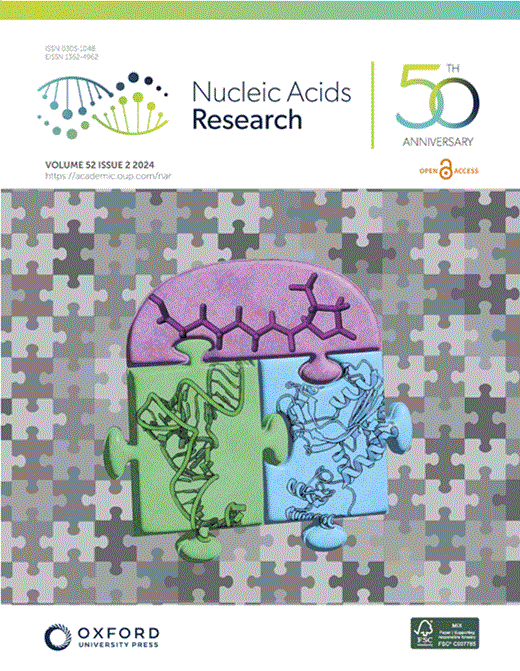SWI5-SFR1在灯丝组装过程中减少RAD51重组酶延伸单元。
IF 16.6
2区 生物学
Q1 BIOCHEMISTRY & MOLECULAR BIOLOGY
引用次数: 0
摘要
同源重组是高保真修复DNA双链断裂的关键途径。重组酶在DNA上组装形成核蛋白细丝是一个至关重要且受到严格调控的步骤。这个过程需要形成一个稳定的细胞核,然后是重组酶的延伸。重组酶的动态组装和拆卸直接影响重组的进展。辅助蛋白,如SWI5-SFR1,调节成核和延伸步骤,调节丝的稳定性和重组效率。在本研究中,我们将研究扩展到RAD51长丝组件的快速延伸阶段。我们发现小鼠SWI5-SFR1有效降低小鼠RAD51在长丝延伸过程中的解离概率,促进长丝更加均匀生长。步长分析显示,mRAD51具有多种低聚单元,以八聚体为优势种。这一观察结果反映了mRAD51的寡聚性质和结构偏好。在mSWI5-SFR1存在的情况下,步长分布向四聚体转移,说明mSWI5-SFR1调节了mRAD51在溶液中的寡聚状态,从而促进了延伸和稳定DNA结合。综上所述,我们的发现弥合了成核和丝组装延伸阶段之间的差距,并提出了RAD51丝形成及其通过辅助蛋白调控以确保基因组稳定性的综合机制。本文章由计算机程序翻译,如有差异,请以英文原文为准。
SWI5-SFR1 reduces RAD51 recombinase extending units during filament assembly.
Homologous recombination is a key pathway for repairing DNA double-strand breaks with high fidelity. The assembly of recombinases on DNA to form nucleoprotein filaments is a crucial and tightly regulated step. This process requires the formation of a stable nucleus, followed by recombinase extension. The dynamic assembly and disassembly of recombinases directly affect recombination progression. Accessory proteins, such as SWI5-SFR1, regulate nucleation and extension steps, modulating filament stability and recombination efficiency. In this study, we extended our investigation to the rapid extension phase of RAD51 filament assembly. We found that mouse SWI5-SFR1 effectively reduces the dissociation probability of mouse RAD51 during filament extension, promoting more uniform filament growth. Step-size analysis revealed that mRAD51 assembles as various oligomeric units, with octamers being the predominant species. This observation reflects both the oligomeric nature and structural preference of mRAD51. In the presence of mSWI5-SFR1, the step-size distribution shifted toward tetramers, indicating that mSWI5-SFR1 modulates the oligomeric state of mRAD51 in solution, thereby facilitating extension and stabilizing DNA binding. Taken together, our findings bridge the gap between the nucleation and extension stages of filament assembly, and propose a comprehensive mechanism for RAD51 filament formation and its regulation by accessory proteins to ensure genome stability.
求助全文
通过发布文献求助,成功后即可免费获取论文全文。
去求助
来源期刊

Nucleic Acids Research
生物-生化与分子生物学
CiteScore
27.10
自引率
4.70%
发文量
1057
审稿时长
2 months
期刊介绍:
Nucleic Acids Research (NAR) is a scientific journal that publishes research on various aspects of nucleic acids and proteins involved in nucleic acid metabolism and interactions. It covers areas such as chemistry and synthetic biology, computational biology, gene regulation, chromatin and epigenetics, genome integrity, repair and replication, genomics, molecular biology, nucleic acid enzymes, RNA, and structural biology. The journal also includes a Survey and Summary section for brief reviews. Additionally, each year, the first issue is dedicated to biological databases, and an issue in July focuses on web-based software resources for the biological community. Nucleic Acids Research is indexed by several services including Abstracts on Hygiene and Communicable Diseases, Animal Breeding Abstracts, Agricultural Engineering Abstracts, Agbiotech News and Information, BIOSIS Previews, CAB Abstracts, and EMBASE.
 求助内容:
求助内容: 应助结果提醒方式:
应助结果提醒方式:


